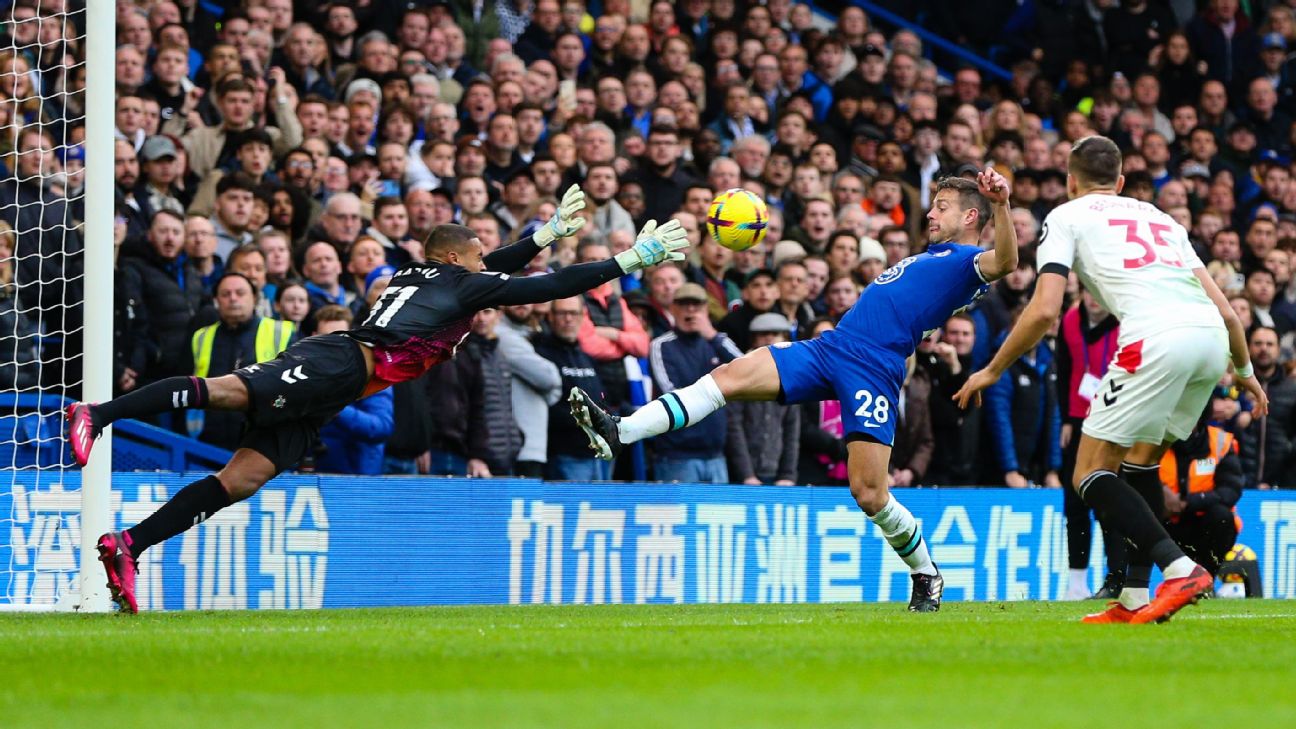At its core, soccer is about figuring out ways to put the ball into your opponent’s net more often than they put it in yours. There are all kinds of stylistic and strategic ways of going about that, but over the long grind of a 38-game season, the teams that score more than their opponents are almost always the teams that create more and better opportunities than they allow.
With a game to go in the Premier League 2022-23 season, Southampton are the only side to have been officially relegated. They have the fewest points (24) and the worst goal differential (-37). That’ll do it, every time. And although they’re still technically alive, Leeds United and Leicester City are both heavily favored to join the Saints in the Championship next season. Leicester have the 14th-best goal differential (-18), and they’re two points behind 17th-place Everton (33); Leeds, and their 17th-best goal differential (-27), are also two back on 31 points.
However, none of the three have been that bad at controlling the balance of chances. Southampton generated 45% of the shots in their games; Leeds are up at 46% — 14th and 13th respectively. And it’s not like they’re all giving up breakaways and shooting from midfield, either. By Expected Goal (xG) differential, which combines the quantity of shots with the quality of shots, Southampton rank 17th, and Leeds rank 15th. Although Leicester have the third-worst shot ratio (42.1%), they have the 14th-best xG differential.
There are many reasons why these three teams are likely to be relegated, some inside their control and plenty of others outside it. But in terms of tangible things we can point to, perhaps the unifying factor behind their poor seasons is that they couldn’t save any shots.
Goals weren’t a problem — except for Southampton
Imagine reading this before the season? Leicester have scored 13 more goals than Chelsea — and they’re heavy favorites to get relegated.
One of the downside risks for Leicester over the past few seasons was the looming decline of striker Jamie Vardy. He’d scored at least 15 goals in five straight seasons, but he was also 35 years old at the start of this campaign. Given that Vardy never contributed much in possession, he seemed particularly at risk of a sudden, massive drop-off.
Vardy scored an incredibly high number of goals from an incredibly small number of touches. Lose a couple of touches or shots per game, and you might suddenly lose a ton of goals. And that’s exactly what happened this season: Vardy barely touched the ball and he’s attempted 1.5 fewer shots than last season.
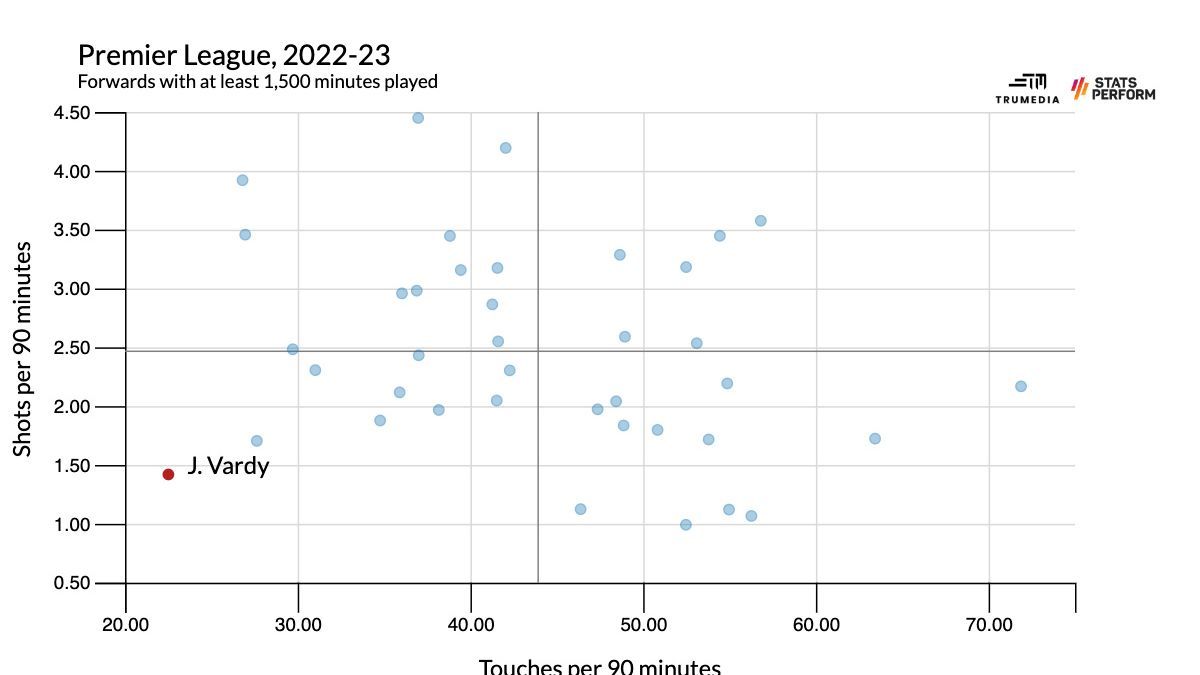
Vardy has only scored three goals this year, but winger Harvey Barnes (12) and midfielder James Maddison (10) have each chipped in with double-digit tallies, while Vardy’s theoretical replacements, Kelechi Iheanacho (5) and Patson Daka (4), have combined for nine in 21 starts. That’s all been enough to produce the 11th-most goals in the league.
Leeds, meanwhile, have always been trying to outscore opponents. It was true under manager Marcelo Bielsa, and as his replacement, Jesse Marsch, told me: “I love scoring goals way more than I dislike giving them up. If we’re winning 2-0, I’m always thinking about 3-0 and rarely thinking about protecting 2-0 or protecting it from going 2-1.”
Both managers were gone by early February, but the team were purposefully built from the front: to attack and defend. They let their star attacker Raphinha join Barcelona for €60 million over the summer and yet they’ve scored five more goals than last season (47), with one game still to go. They’re two behind Leicester (49), with the 12th-most in the league.
Southampton (32), meanwhile, have only outscored Wolves (31) through 37 games. James Ward-Prowse leads the team with 10 goals, but most of those came from free kicks and penalties. Only one player in the Southampton squad has scored more than two open-play goals (Che Adams, with three), and only three others have scored more than one (Ward-Prowse, Romain Perraud, and Joe Aribo.)
Very few teams manage to stay up without scoring at least 40 goals. And unless they bang in eight on Sunday against Liverpool, Southampton are going to fall way short.
Goalkeepers were a problem — for everyone
Now, you can avoid relegation without scoring many goals. In recent seasons, Huddersfield stayed up with 28, Crystal Palace did it with 31, and Burnley scraped by with 33. They couldn’t score, but they were all able to defend — just enough.
In some ways, Southampton have done that. They’ve conceded 13.4 shots per game, which ranks 12th in the league, one spot ahead of Tottenham. That, roughly, lines up with the quality of the shots they’re conceding, too, as they’ve allowed 58.01 xG, which ranks 14th in the league. However, they’ve conceded 69 actual goals, the second-most in the league.
There’s something strange going on here, too. You might think that Southampton have been a bit unlucky with how well their opponents are taking their chances. Almost every relegated team have had at least some form of uncontrollable variance go against them. But Southampton’s opponents have really struggled to find the corners this season — and the shots have still gone in.
Per Stats Perform’s post-shot xG model — which takes into account where the ball ends up on the goal frame, in addition to the location-based factors used by the traditional xG models you see on TV or in columns like the one you’re currently reading — Southampton’s opponents were expected to score just 43.31 goals. They were fortunate that their opponents struggled with their shot placement, but then both of their keepers, Alex McCarthy and Gavin Bazunu, struggled to keep the ball out of the net.
The gap between Southampton’s post-shot xG conceded and their 61 actual G conceded — 20.69 — is by far the biggest in the Premier League this season, and is probably one of the biggest you’ll ever see.
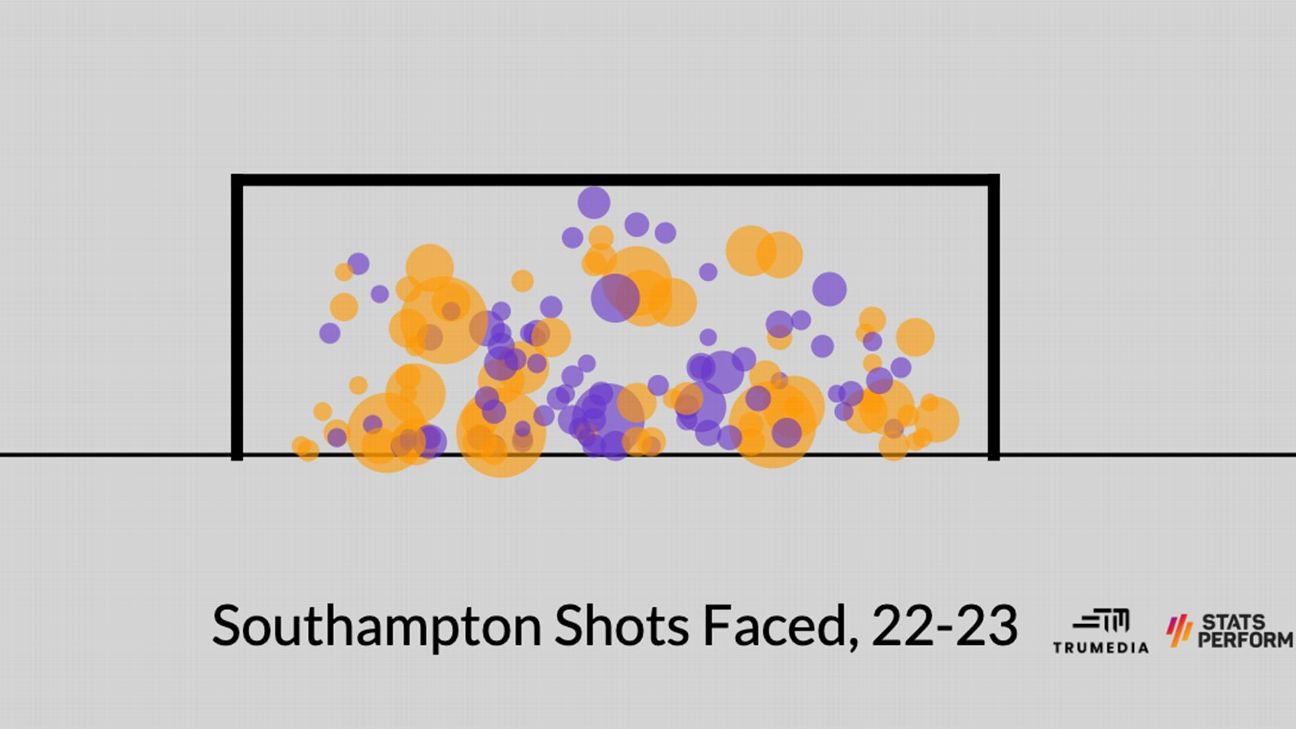
After Southampton, the second-biggest strugglers when it comes to stopping shots are Leeds. They’ve faced shots worth 61.34 post-shot xG, and they’ve conceded a league-high 74 goals.
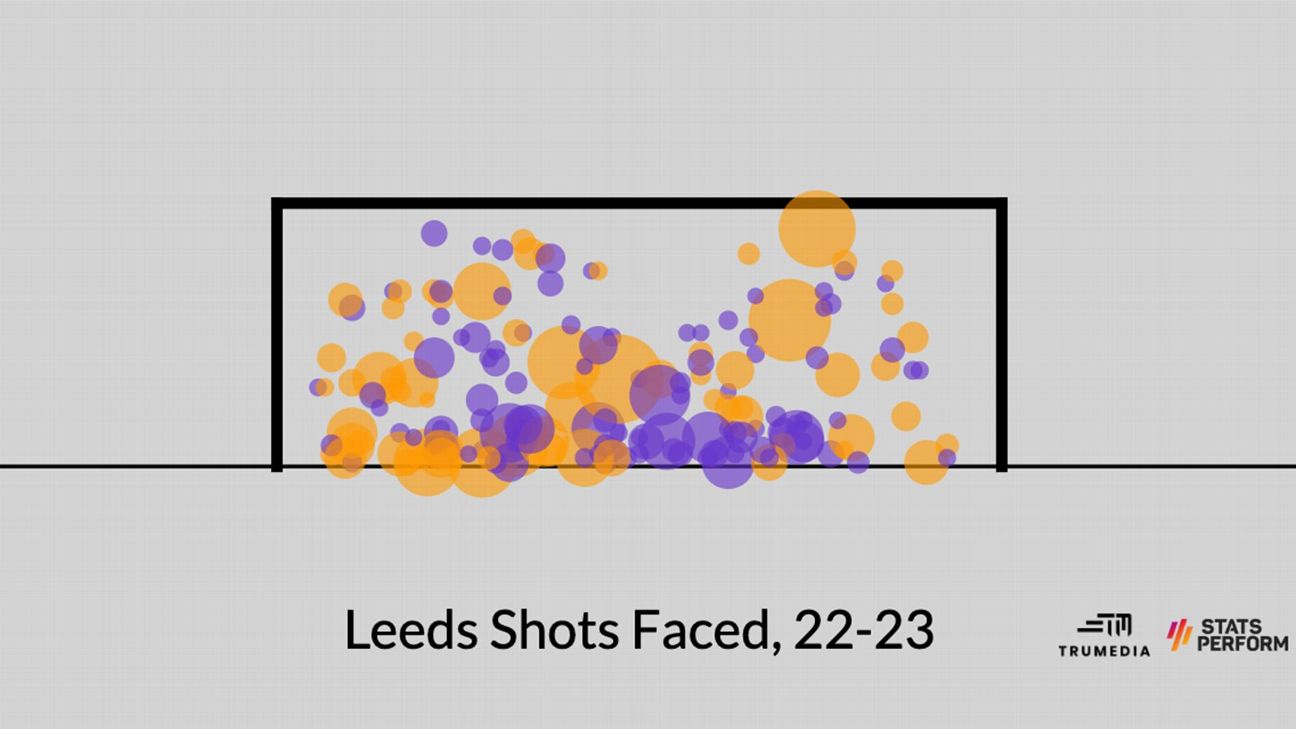
Third-worst? Yep, it’s Leicester City: 67 goals on 55.9s post-shot xG.
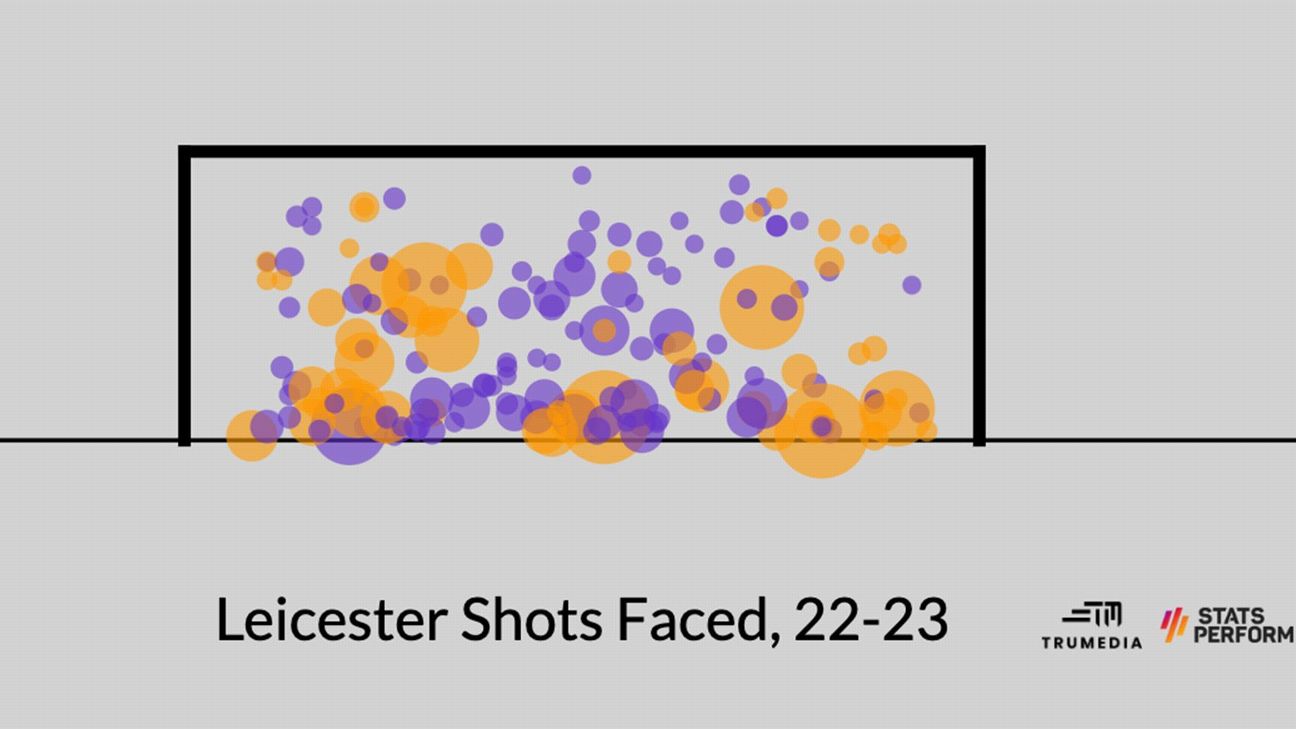
In the case of both Leeds and Southampton, they rolled the dice on a pair of young goalkeepers. In his three years in the Premier League, 23-year-old Illan Meslier has allowed 31.1 more goals than expected. Perhaps uncoincidentally, Leeds’ best season coincided with Meslier’s best shot-stopping campaign in 2020-21, but last year he was 16 goals below average and this season he was around 12 — before new manager Sam Allardyce benched him in favor of Joel Robles.
As part of the club’s wider pivot toward untested young talent, Southampton signed the 21-year-old Bazunu over the summer from Manchester City for £12m. He’d never started a game in a professional top flight or even a professional second division, and he has the worst save percentage (54.2%) of any starting keeper across Europe’s Big Five leagues. The Premier League average is 69%.
Leicester took a similar risk to Bazunu by bringing in the older Danny Ward. When Kasper Schmeichel suddenly left the club after 11 years to join Nice over the summer, Ward stepped up to become No. 1. Ward, the 29-year-old acquired from Liverpool for £12.5m back in 2018, hadn’t been a full-time starter since 2016-17 with Huddersfield in the Championship, and his only other season of starting play came for Aberdeen in the Scottish Premiership the year prior. This season, he became the starter and conceded 5.5 more goals than expected before being replaced by Daniel Iversen toward the end of Brendan Rodgers’ time in charge.
Now, these kinds of shot-stopping numbers can be pretty volatile from year to year, as not every factor is being measured and different keepers are better at saving different kinds of shots. Meslier is typically facing some of the most difficult shots in the league because of the way Leeds play, and Southampton’s shot-stopping struggles extend back to each of the previous two seasons, both before Bazunu joined the club. Schmeichel hadn’t lit the world on fire in recent seasons for Leicester, either. Plus, all three are comfortable and effective sweeper-keepers: cutting out an attack before it leads to a shot won’t show up in an xG model.
However, poor shot-stopping has a much bigger negative impact than any aspect at any other position. A bad defender can get support from other defenders. A poor attacker might just float through matches without affecting the game, while his teammates pick up the slack. But there’s only one player on the field who is allowed to use his hands; once the shot starts heading toward goal, his teammates can’t really help him save it.
And so, teams facing a realistic threat of relegation — i.e., everyone outside of the Big Six and Newcastle — would be better off prioritizing a higher floor of average-ish goalkeeping performance, rather than shooting for a star. Since the majority of shot-stopping comes down to instincts and positioning — not the memorable highlight-reel saves — most goalkeepers don’t peak until they’re deep into their 20s or even their 30s. And since there are so few shots faced by a given keeper in any given season, you need a significant track record of prior shot-stopping performance to have any kind of confidence in what you’re seeing.
In Ward, Leicester went for an older keeper with a Liverpool pedigree, but without much game time and without much previous performance to create that confidence in any kind of assessment. While in Bazunu and Meslier, Southampton and Leeds opted for younger talents whom they hoped might make a sudden leap. All three clubs took big risks. And if they hadn’t, they might all still be in the Premier League next season.
